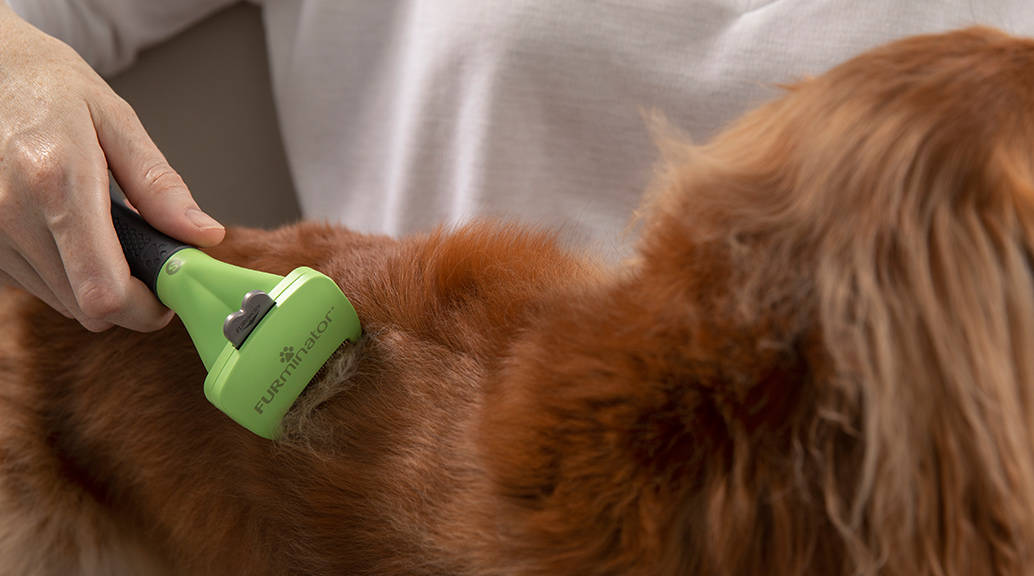Whatever stage the coat has reached within the growth cycle, it is the undercoat that dictates the amount of grooming a coat needs and how it is groomed. Until you have gained some experience, and have learnt to recognize the challenges that undercoats present, knowing what tools to use and where to start can appear baffling.
The undercoat is the most complex and problematic of the two hair structures because:
- Undercoat hairs are more numerous than topcoat hairs
- The amount of undercoat hair depends on the environment that the dog (or type of dog) originally inhabited
- Undercoat hairs are deciduous so they die or shed when they are surplus to requirements or need to be replaced
- Their number fluctuates according to the season
- The sex of the dog can also have a bearing on the undercoat density
- Neutering can affect the behaviour of the undercoat
- Previous grooming and styling can also affect the undercoat.
All of these factors can influence the undercoat. Varying densities of soft, often dirty, coat may be seen. If this does not shed from the hair follicles and fall free from the coat, it typically can become horrendously knotted.The resulting mats and wadding will need to be groomed out.
For each new dog the learner should consider:
- The breed profile. What ‘type’ of coat does the breed have and how should it behave? What are the daylight hours and temperatures of the geographical region in which the breed developed, and how will these have affected undercoat behaviour?
- The effect that different grooming and styling methods have on undercoat behaviour compared to topcoat behaviour.
There are several ways to remove the undercoat, depending on the length and condition of the hair. Select the tools and equipment for each stage of the grooming process, that will help you the best for each task.
Massage
Suitable tools: rubber glove, mitt or pad.
These tools all do the same job. They are used on smooth coats because they are gentle on the skin and effectively massage the dog to remove the hair. The tools are used in a circular motion and the friction caused by the rubber on the coat warms the rubber, making it adhere to the fine hairs.
This method of grooming allows a considerable amount of dirt and dander to be removed at the same time as the hair. You are therefore strongly advised to wear a face mask.
TECHNIQUE
The glove, mitt or pad is used in a circular motion, starting on the dog’s thigh and working forwards towards the head so that the coat is separated and removed at skin level. The rubber tool can be used in an up and down motion on the legs, and tails if you find that easier. It is safe to use these tools on the face but a little caution is needed to prevent hairs and dander from entering the eyes.
Raking
Suitable tools: rakes, furminators, combs.
The rake does as its name suggests and rakes the coat away from the skin. These tools can be very harsh if used with too much vigour as the tapering teeth are hard and can be sharp.
TECHNIQUE
On a short coat, lift the coat up the “wrong” way with your supporting hand. You may or may not be able to see the skin easily at this point. Insert the tool gently into the coat and, without using too much pressure, drag the tool gently along the coat in the direction of coat growth.
Make your strokes short so you are not pulling the coat too hard. You should frequently check the skin below your working area, especially if the teeth on the rake are longer than the depth of coat. If the skin is becoming sore, move to another area to rest the skin before going back to it, and practice using less pressure on your rake.
On a very dense, longer coat, you need to change the angle at which you insert the rake when you begin until the coat starts to break up and separate. Lift the coat with your supporting hand and insert the rake sideways on into the coat and pull it out towards you.
This enables you to use the rake to pick your way down through the depth of coat until you can safely reach and see the skin. On very dense but shorter coats it may be easier to use a coarse comb to rake out and break up the undercoat.

